Jan Lindhe. Clinical Periodontology
Подождите немного. Документ загружается.


TREATMENT OF FURCATION-INVOLVED TEETH • 725
Fig. 29-41. Internal morphology of the furcation of a
maxillary molar. Note the invagination of the palatal
root.
Fig. 29-42. Exposure of the membrane and of the furca
-
tion entrance as a consequence of recession of the flap
margin. The photograph is taken at 3 weeks of healing
after GTR treatment of a degree II buccal furcation of a
mandibular molar.
Fig. 29-43. Aspect of a lingual degree II furcation involvement in a mandibular first molar. Note the infrabony com-
ponent of the defect and the level of the approximal supporting bone in relation to the furcation fornix (a). The Tef-
lon
membrane sutured in position and supported by the interproximal alveolar bone (b). The flap positioned and
sutured over the membrane (c). At re-entry, after 6 months of healing, the previously exposed furcation defect was
closed and filled with bone tissue (d).
GTR treatment could be considered in dentitions with
isolated degree II furcation defects in mandibular mo-
lars. The predictability of this treatment outcome im-
proves following GTR therapy if:
• The
interproximal
bone is located at a level which is
close to the CEJ of the approximal surface. This
"key-
hole" type of degree II involvement allows for
an effective retention of the membrane material and
retention also of the position of the coronally placed
flap margins (Fig. 29-43a-d).
• The debridement of the exposed root surfaces in the
furcation area is comprehensive. Since the width of
the furcation entrance and the internal morphology
of
the interradicular area may limit the access of the
curettes for proper debridement, the removal of
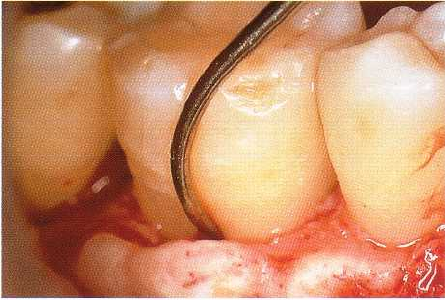
726 •
CHAPTER
29
Fig. 29-44. Phase of debridment of a buccal degree II
furcation defect by the use of an "extra-fine" ultrasonic
tip.
hard and soft bacterial deposits from the root sur-
faces must frequently be made with ultrasonic in-
struments, rotating, flame-shaped fine diamond
burs and endodontic files (Fig. 29-44).
•
The membrane material is properly placed and a "
space" between the tooth and the material establ-
ished. A "primary" wound closure is hereby ob-
tained, blood-clot protection will occur and reces-
sion of the soft tissue margin during the early phase
of healing will be minimized (Fig. 29-45a-h).
•
A plaque control program is put in place. This
should include daily rinsing with a chlorhexidine
solution and professional toothcleaning once a
week for the first month, and once every 2-3 weeks
for at least another 6 months of healing following
the surgical procedure.
The outcome of the regenerative procedures at furca-
tion-involved molars should result in the complete
elimination of the defect within the interradicular
space in order to establish anatomic conditions which
facilitate optimal self-performed plaque control meas-
ures. In fact, partial gain of clinical attachment levels
within the furcation defect, although statistically sig-
nificant, will not necessarily improve the site's acces-
sibility for plaque control measures.
Extraction
The extraction of a furcation-involved tooth must be
considered when the attachment loss is so extensive
that no root can be maintained or when the treatment
will not result in a tooth/gingival anatomy which
allows proper self-performed plaque control meas-
ures.
Moreover, extraction can be considered as an alter
-
native form of therapy when the maintenance of the
affected tooth will not improve the overall treatment
plan or when, due to endodontic or caries-related
lesions, the preservation of the tooth will represent a
risk factor for the long-term prognosis of the overall
treatment.
The possibility of substituting a furcation-involved
tooth with an osseointegrated implant should be con-
sidered with extreme caution and only if implant
therapy will improve the prognosis of the overall
treatment (see Chapter 31). In fact, the implant alter-
native has obvious anatomic limitations in the maxil-
lary and mandibular molar regions.
PROGNOSIS
Several studies have evaluated the long-term progno-
sis of multirooted teeth with furcation involvement
that were treated in accordance with the principles
described in this chapter (Table 29-2). In a 5-year study,
Hamp et al. (1975) observed the outcome of treatment
of 175 teeth with various degrees of furcation involve-
ment in 100 patients. Of the 175 teeth, 32 (18%) were
treated by scaling and root planing alone, 49 (28%)
were subjected, in addition to scaling and root plan-
ing, to furcation plasty which included odonto and/ or
osteoplasty. In 87 teeth (50%) root resection had been
carried out and in seven teeth (4%) a tunnel had been
prepared. At the completion of the active phase of
therapy the patients were enrolled in a maintenance
program which included a recall visit every 3-6
months. The plaque and gingivitis scores assessed
immediately after treatment and once a year during
maintenance indicated that the patients' oral hygiene
was of high quality. None of the teeth treated was lost
during the 5 years of study. Only 16 furcation sites
exhibited probing depths exceeding 3 mm. During the
observation period carious lesions were detected in 12
surfaces of the 32 teeth which had been treated by
scaling and root planing, in three surfaces of the 49
teeth subjected to furcation plasty, in five surfaces of
the 78 root-resected teeth and in four surfaces of the
seven teeth where a tunnel was prepared. The results
of this study were basically confirmed in a more recent
investigation (Hamp et al. 1992). In this 7-year study,
the authors followed 100 patients with 182 furcation-
involved teeth. Out of the 182 furcation-involved
teeth, 57 had been treated by scaling and root planing
only, 101 were treated by furcation plasty and 24 were
subjected to root resection or hemisection. No tunnel
preparation was performed. After the active phase of
therapy, the patients were enrolled in a meticulous

TREATMENT OF FURCATION-INVOLVED TEETH • 727
Fig. 29-45a-f. The sequential stages of GTR treatment of a buccal degree II furcation-involved mandibular first mo-
lar.
The clinical appearance and the horizontal probing of the defect (a, b). Membrane placement and retention (c, d).
The clinical aspect of the soft tissue at 4 weeks after membrane removal (e). The clinical aspect after 6 months of
healing (f). During the re-entry procedure the furcation defect appeared completely closed (g) and was not probe-
able (h).
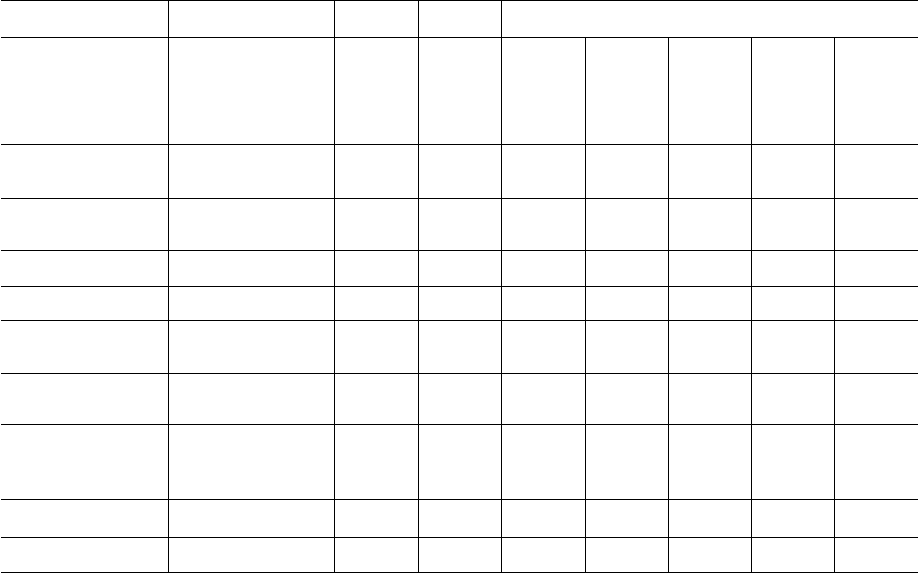
728 • CHAPTER 29
Table 29-2. Long-term clinical studies on root resection therapy in molars with furcation involvement
Causes of tooth loss
Author
Observation period
No. of
teeth
examined
%
teeth
lost
%
root/
tooth
fracture
%
perio-
dontal
%
endo-
dontic
%
caries
or
decemen-
tation
%
strategic
Bergenholtz (1972)
21 teeth / 2-5 yrs
17 teeth / 5-10 yrs
45
6 4 2
Klavan (1975)
3 yrs
34
3 3
Hamp et al. (1975) 5 yrs
87
0
Langer et al. (1981) 10 yrs
100 38 18 10
7 3
Erpenstein (1983)
4-7 yrs
34
9 3 6
Buhler (1988)
10 yrs
28 32
3.
6
7.
1
17.7
3.
6
Carnevale et at (1991)
303 teeth / 3-6 yrs
185 teeth /
7-11 yrs
488
4
1.
8
0.
4
0.9
0.
9
Basten et al. (1996)
2-23 yrs
49
8 2 4 2
Carnevale at al. (1998)
10 yrs
175
7
1.
1
1.
8
2.3
1.
8
maintenance-care program including recall appoint-
ments once every 3-6 months.
During the course of the study, more than 85% of
the furcations treated with scaling root planing alone,
or in conjunction with furcation plasty, maintained
stable conditions or showed signs of improvement.
Only one tooth and one mesial root of a mandibular
molar were extracted among the root-resected or
hemisected teeth.
Carnevale et al. (1998), in a 10-year prospective
controlled clinical trial, demonstrated a 93% survival
rate of root resected furcation-involved teeth and a
99% survival rate of non-furcation involved teeth.
More recently, Svardstrom (2001) presented the re-
sults of a retrospective analysis on factors influencing
the decision-making process regarding the treatment
for 1313 molars with furcation involvement in 222
patients and the outcome of the treatment decisions
after 8-12 years (mean 9.5 years) of regular mainte-
nance care. The treatment options included were:
tooth extraction, root separation/resection and main-
tenance of the tooth with non-surgically/surgically
performed scaling and root-planing with or without
furcation plasty. Of the 1313 furcation-involved mo-
lars, 366 (28%) were extracted during the active phase
of therapy. The decision for tooth extraction was pri-
marily influenced by factors such as tooth mobility,
tooth position, absence of occulusal antagonism, the
degree of furcation involvement, probing depth and
the amount of remaining periodontal support. Out of
the 685 molars with furcation involvement and the 160
patients that were available for the follow-up exami-
nation 8-12 years after treatment, 47 teeth were root
separated/resected and 638 teeth were considered to
be maintainable after a non-surgical or conservative
surgical therapy.
The factor found to have the strongest influence for
the decision to perform root separation/resection was
the degree of furcation involvement (class II and III).
Tooth position, probing depth and tooth mobility
were also factors of statistical significance. The author
explained that other factors such as endodontic con-
ditions, root anatomy and overall treatment strategy
may also have influenced the choice of treatment. The
long-term outcome of the treatment decisions made
for furcation-involved molars showed a favorable sur-
vival rate for both root resective (89%) and non-resec-
tive (96%) therapy options in patients included in a
proper maintenance care program.
Of the 47 root separated/resected teeth, only 5
(
11%) were lost during the 9.5 years of follow-up. Of
the 638 molars initially considered to be maintainable
by a non-resective treatment, 21 teeth (3.5%) were
extracted and 3 teeth were root resected.

TREATMENT OF FURCATION-INVOLVED TEETH • 729
Table 29-3. Factors to consider in treatment of furcation-involved molars
Tooth-related factors
Degree of furcation involvement
Amount of remaining periodontal support
Probing depth
Tooth mobility
Endodontic conditions and root/root-canal anatomy
Available sound tooth-substance
Tooth position and occlusal antagonisms
Patient-related factors
Strategic value of the tooth in relation to the overall plan
Patient's functional and esthetic demands
Patient's age and health conditions
Oral hygiene capacity
Conclusion
When it comes to treatment decisions for furcation-in-
volved molars, it must be realized that there is no
scientific evidence that a given treatment modality is
superior to the others (Table 29-3).
REFERENCES
Abrams, L. & Trachtenberg, D.I. (1974). Hemisection-technique
and restoration.
Dental Clinics of North America
18,
415-444.
Basten, C.H.J., Ammons, W.F.J. & Persson, R. (1996). Long-term
evaluation of root-resected molars: a retrospective study.
In-
ternational Journal
of
Periodontics and Restorative Dentistry
16,
207-219.
Bergenholtz, G. (1972). Radectomy of multi-rooted teeth.
Journal
of
American Dental Association 85,
870-875.
Bower, R.C. (1979a). Furcation morphology relative to periodon-
tal treatment. Furcation entrance architecture.
Journal
of
Peri-
odontology 50,
23-27.
Bower, R.C. (1979b). Furcation morphology relative to periodon
tal
treatment. Furcation root surface anatomy.
journal
of
Peri-
odontology 50,
366-374.
Btihler, H. (1988). Evaluation of root resected teeth. Results after
ten years.
Journal of Periodontology 59,
805-810.
Caffesse, R., Smith, B., Duff, B., Morrison, E., Merril, D. & Becker,
W. (1990). Class II Furcations treated by guided tissue regen-
eration in humans: case reports.
Journal
of
Periodontology
61,
510-514.
Carnevale, G., Di Febo, G. & Trebbi, L. (1981). A patient presen-
tation: planning a difficult case.
International Journal
of
Perio-
dontics and Restorative Dentistry 6,
51-63.
Carnevale, G., Di Febo, G., Tonelli, MY, Marin, C. & Fuzzi, M.
(
1991). A retrospective analysis of the periodontal-prosthetic
treatment of molars with interradicular lesions.
International
Journal
of
Periodontics and Restorative Dentistry
11,
189-205.
Carnevale, G., Freni Sterrantino, S. & Di Febo, G. (1983). Soft and
hard tissue wound healing following tooth preparation to the
alveolar crest.
International Journal
of
Periodontics and Restora-
tive Dentistry 3,
36-53.
Carnevale, G., Pontoriero, R. & Di Febo, G. (1998). Long-term
effects of root-resective therapy in furcation-involved molars.
A
10-year longitudinal study
Journal
of
Clinical Periodontology
25,
209-214.
Di Febo, G., Carnevale, G. & Sterrantino, S.F. (1985). Treatment
of a case of advanced periodontitis: clinical procedures util-
izing the "combined preparation
"
technique.
International
Journal
of
Periodontics and Restorative Dentistry
1,
52-63.
Erpenstein, H. (1983). A 3 year longitudinal study of hemisec-
tioned molars.
Journal of Clinical Peridontology
10, 1-10.
Cher, M.E. & Vernino, A.R. (1980). Root morphology-clinical
significance in pathogenesis and treatment of periodontal
disease.
Journal
of
American Dental Association
101,
627-633.
Gottlow, J., Nyman, S., Lindhe, J., Karring, T. & Wennstrom, J.
(
1986). New attachment formation in the human periodon
tium
by guided tissue regeneration. Case reports.
Journal
of
Clinical
Periodontology 13,
604-616.
Hamp, S.E., Nyman, S. & Lindhe, J. (1975). Periodontal treatment
of multirooted teeth. Results after 5 years.
Journal
of
Clinical
Periodontology 2,
126-135.
Hamp, S.E., Ravald, N., Tewik, A. & Lundstrom, A. (1992).
Perspective a long terme des modalites de traitement des
lesions inter-radiculaires.
Journal de Parodontologie
11,
11-23.
Joseph, I., Varma, B.R.R. & Bhat, K.M. (1996). Clinical signifi-
cance of furcation anatomy of the maxillary first premolar: a
biometric study on extracted teeth.
Journal
of
Periodontology
67,
386-389.
Klavan, B. (1975). Clinical observation following root amputa
tion
in maxillary molar teeth.
Journal of Periodontology 46,
1-5.
Langer, B., Stein, S.D. & Wagenberg, B. (1981). An evaluation of
root resection. A ten years study
Journal
of
Periodontology 52,
719-722.
Larato, D.C. (1975). Some anatomical factors related to furcation
involvements.
Journal of Periodontology 46,
608-609.
Lekovic, V., Kenney, E.B., Kovacevic, K. & Carranza, F.A. Jr.
(
1989). Evaluation of guided tissue regeneration in class II
furcation defects. A clinical re-entry study.
Journal
of
Periodon-
tology 60,
694-698.
Levine, H.L. (1972). Periodontal flap surgery with gingival fiber
retention.
Journal
of
Periodontology
43,
91-98.
Metzeler, D., Seamons, B.C., Mellonig, J.T., Marlin, G.E. & Gray
J.
L. (1991). Clinical evaluation of guided tissue regeneration
in
the treatment of maxillary class 11 molar furcation invasion.
Journal of Periodontology 62,
353-360.
Pontoriero, R. & Lindhe, J. (1995a). Guided tissue regeneration in
the treatment of degree Ill furcation defects in maxillary
molars.
Journal
of
Clinical Periodontology 22,
810-812.
Pontoriero, R. & Lindhe, J. (1995b). Guided tissue regeneration
in
the treatment of degree II furcation in maxillary molars.
Journal
of
Clinical Periodontology 22,
756-763.
Pontoriero, R., Lindhe, J., Nyman, S., Karring, T., Rosenberg, E.
& Sanavi, F. (1988). Guided tissue regeneration in degree II
730
• CHAPTER
29
furcation involved mandibular molars. A clinical study
Jour-
nal of Clinical Periodmitolog:i
15, 247-254.
Pontoriero, R., Lindhe, J., Nyman, S., Karring, T., Rosenberg, E.
&
Sanavi, F.
(1989).
Guided tissue regeneration in the treat
ment
of furcation defects in mandibular molars. A clinical
study of
degree III involvements.
Journal of Clinical Periodon
tology
16,
170-174.
Ramfjord, S.P., Nissle, L.L.
(1974).
The modified Widman flap.
Journal of PeriodontoloNT 45,
601-607.
Rosenberg, M.M.
(1978).
Management of osseous defects.
Clini
cal Dentistry 3,
103.
Rosenberg, M.M.
(1988).
Furcation involvement: periodontic,
endodontic and restorative interrelationships. In: Rosenberg,
M.M., Kay, H.B., Keough, B.E. & Holt, R.L., eds.
Periodontal
and prosthetic management for advanced cases
Chichago: Quin-
tessence, pp.
249-251.
Ross, I.F. & Thompson, R.H.
(1980).
Furcation involvement in
maxillary and mandibular molars.
Journal of Periodontology
51,
450-454.
Smukler, H. & Tagger, M.
(1976).
Vital root amputation. A clinical
and histologic study.
Journal of Periodontology
47, 324-330.
Svardstrom, G.
(2001).
Furcation
involvements
in periodontitis pa
tients.
Prevalence and treatment
decisions.
Thesis. Department
of
Peridontology, Faculty of Odontology, Goteborg Univer
sity, pp.
31.
Svardstrom, G. & Weimstrom, I.
(1988).
Furcation topography of
the maxillary and mandibular first molars.
Journal
of
Clinical
Periodontology
15, 271-275.

CHAPTER 30
Occlusal Therapy
JAN LINDHE AND STURE NYMAN
Clinical symptoms of trauma from occlusion
Angular bony defect
Increased tooth mobility
Progressive tooth mobility
Tooth mobility
Initial and secondary tooth mobility
Clinical assessment of tooth mobility
Treatment of increased tooth mobility
CLINICAL SYMPTOMS OF
TRAUMA FROM OCCLUSION
Angular bony defect
It has been claimed that
angular bony defects
and
in-
creased tooth mobility
are important symptoms of
trauma from occlusion (Glickman 1965, 1967). The
validity of this suggestion has, however, been ques-
tioned (see Chapter 15). Thus, angular bony defects
have been found at teeth affected by
trauma from occlu-
sion
as well as at teeth with normal occlusal function
(
Waerhaug 1979).
This
means that the presence of angular
bony defects cannot
per se
be regarded as an exclusive
symptom of trauma from occlusion.
Increased tooth mobility
Increased tooth mobility,
determined clinically, is ex-
pressed in terms of amplitude of displacement of the
crown of the tooth. Increased tooth mobility can, in-
deed, be observed in conjunction with
trauma from
occlusion.
It may, however, also be the result of a reduc
-
tion of the height of the alveolar bone with or without
an accompanying angular bony defect caused by
plaque-associated periodontal disease (see Chapter
5)
. Increased tooth mobility resulting from occlusal
interferences may further indicate that the periodon-
tal structures have become adapted to an altered func
-
tional demand, i.e. a widened periodontal ligament
with a normal tissue composition has become the end
result of a previous phase of progressive tooth mobil-
ity (see Chapter 15) associated with trauma from oc-
clusion.
Progressive (increasing) tooth mobility
In Chapter 15, it was concluded that the diagnosis
trauma from occlusion should be used solely in situ-
ations where a progressive mobility could be ob-
served. Progressive tooth mobility can be identified
only through a series of repeated tooth mobility meas
-
urements carried out over a period of several days or
weeks.
TOOTH MOBILITY CROWN
EXCURSION/ROOT
DISPLACEMENT
Initial and secondary tooth mobility
A tooth which is surrounded by a normal periodon-
tium may be moved (displaced) in horizontal and
vertical directions and may in addition be forced to
perform limited rotational movements. Clinically,
tooth mobility is usually assessed by exposing the
crown of the tooth to a certain force and determining
the distance the crown can be displaced in buccal
and/or lingual direction. The mobility (= movability)
of a tooth in a horizontal direction is closely depend-
ent on the height of the surrounding supporting bone,
the width of the periodontal ligament as well as the
shape and number of roots present (Fig. 30-1).
The mechanism of tooth mobility was studied in
detail by Muhlemann (1954, 1960) who described a
standardized method for measuring even minor tooth
displacements. By means of the "Periodontometer" a
small force
(
.
-100 pounds) is applied to the crown of a
tooth (Fig. 30-2). The crown starts to tip in the direction
of the force. The resistance of the tooth-supporting
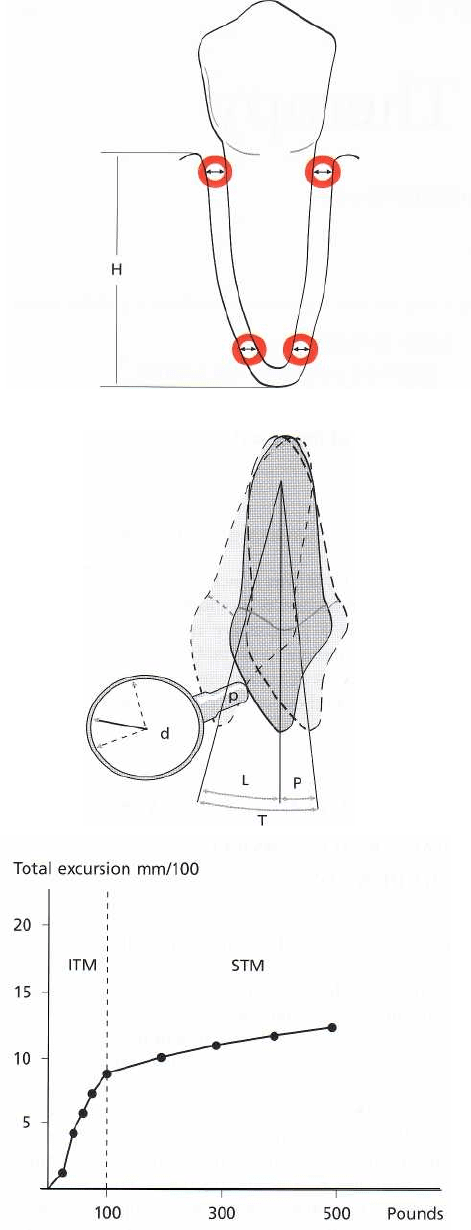
732 • CHAPTER 30
Fig. 30-1. The mobility of a tooth in horizontal direc
tion
is dependent on the height of the al
v
eolar bone
(H), the
width of the periodontal ligament (encircled ar
rows)
and the shape and number of roots.
Fig. 30-2. Tooth mobility measurements by means of
the Periodontometer. d: dial indicator. p: pointer. L: la-
bial excursion of the crown. P: palatal excursion of the
crown, T = L+P: total excursion of the crown.
Fig. 30-3. Initial tooth mobility (ITM) means the excur-
sion of the crown of a tooth when a force of 100
pounds is applied to the crown. Secondary tooth mobil-
ity (STM) means the excursion of the crown of the
tooth when a force of 500 pounds is applied.
structures against displacement of the root is low in
the initial phase of force application and the crown is
moved only 5/100-10/100 mm. This movement of the
tooth was called
"initial tooth mobility-ITM"
by Miihle-
mann (1954) and is the result of an
intraalveolar
dis-
placement of the root (Fig. 30-3). In the pressure zone
(
see Chapter 15) there is a 10% reduction in the width of
the periodontal ligament and in the tension zone there is
a corresponding increase. Muhlemann & Zan-
der (
1954) stated that "there are good reasons to as
sume
that the initial displacement of the root
(initial-TM)
corresponds to a reorientation of the periodontal
membrane fibers into a position of functional readi
ness
towards tensile strength". The magnitude of the
"initial-
TM"
varies from individual to individual,
from tooth to
tooth, and is mainly dependent on the structure and
organization of the periodontal liga
ment. The
"initial-
TM"
value of ankylosed teeth is
therefore zero.
When a larger force (— 500 pounds) is applied to the
crown, the fiber bundles on the tension side cannot
offer sufficient resistance to further root displacement.
The additional displacement of the crown that is ob-
served in
"secondary tooth mobility-secondary-TM"
(Fig.
30-3) is allowed by distortion and compression of the
periodontium in the pressure side. According to
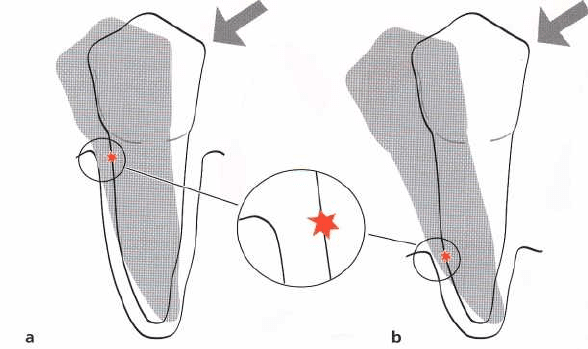
OCCLUSAL THERAPY • 733
Fig. 30-4. (a) The normal "physi-
ologic
"
mobility of a tooth with
normal height of the alveolar bone
and normal width of the periodon
-
tal ligament. (b) The mobility of a
tooth with reduced height of the
alveolar bone. The distance of the
horizontal displacement of the re-
ference point (*) on the roots is the
same in the two situations (a,b).
Muhlemann (1960) the magnitude of
"secondary-TM",
i.e. the excursion of the crown of the tooth when a force
of 500 pounds is applied, (1) varies between different
types of teeth (e.g. incisors 10-12/100 mm, canines
5-9/100 mm, premolars 8-10/100 mm and molars
4-8/100 mm), (2) is larger in children than in adults,
and (3) is larger in females than males and increases
during, for example, pregnancy. Furthermore, tooth
mobility seems to vary during the course of the day;
the lowest value is found in the evening and the
largest in the morning.
A new method for determining tooth mobility was
presented by Schulte and co-workers (Schulte 1987,
Schulte et al. 1992) when the Periotest
"
(SiemensAG,
Bensheim, Germany) system was introduced. The Pe-
riotest device measures the reaction of the periodon-
tium to a defined percussion force which is applied to
the tooth and delivered by a tapping instrument. A
metal rod is accelerated to a speed of 0.2 m/s with the
device and maintained at a constant velocity. Upon
impact the tooth is deflected and the rod decelerated.
The contact time between the tapping head and the
tooth varies between 0.3 and 2 milliseconds and is
shorter for stable than mobile teeth. The Periotest scale
(the Periotest values) ranges from – 8 to + 50 and the
following ranges should be considered:
•
– 8 to +9: clinically firm teeth
•
10 to 19: first distinguishable sign of movement
•
20 to 29: crown deviates within 1 mm of its normal
position
•
30 to 50: mobility is readily observed.
The Periotest values correlate well with (1) tooth mo-
bility assessed with a metric system, and (2) degree of
periodontal disease and alveolar bone loss. There are
reasons to suggest that the simple Periotest device in
the future will be used in both the clinic and in re-
search settings.
Clinical assessment of tooth mobility
(
physiologic and pathologic tooth mobility)
If, in the traditional clinical measurement of tooth
mobility, a comparatively large force is exerted on the
crown of a tooth which is surrounded by a normal
periodontium, the tooth will tip within its alveolus
until a closer contact has been established between the
root and the marginal (or apical) bone tissue. The
magnitude of this tipping movement, which is nor-
mally assessed using the tip of the crown as a reference
point, is referred to as the
"physiologic"
tooth mobility
The term
"physiologic"
implies that
"pathologic"
tooth
mobility may also occur.
What, then, is "pathologic" tooth mobility?
1.
If a similar force is applied to a tooth which is
surrounded by a periodontal ligament with an in-
creased width, the excursion of the crown in hori-
zontal direction will become increased; the clinical
measurement consequently demonstrates that the
tooth has an increased mobility. Should this in-
creased mobility be regarded as
"pathologic"?
2.
An increased tooth mobility, i.e. an increased dis-
placement of the crown of the tooth after force
application, can also be found in situations where
the height of the alveolar bone has been reduced
but the remaining periodontal ligament has a nor-
mal width. At sites where this type of bone loss is
extensive, the degree of tooth mobility (i.e. excur-
sion of the crown) may be pronounced. Should this
increased tooth mobility be regarded as "pathol-
ogic"?
Fig. 30-4b illustrates a tooth which is surrounded
by alveolar bone of reduced height. The width of
the remaining periodontal ligament, however, is
within normal limits. A horizontally directed force
applied to the crown of the tooth will in this case
result in a larger excursion of the crown than if a
similar force is applied to a tooth with normal
height of the alveolar bone and normal width of the
periodontal ligament (Fig. 30-4a). There are reasons
to suggest that the
so-called increased mobility
meas-
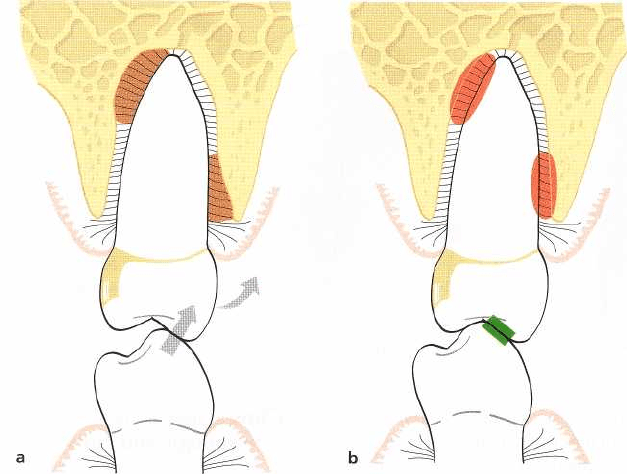
734 • CHAPTER 30
Fig. 30-5. (a) Contact relationship between a mandibular and a maxillary premolar in occlusion. The maxillary pre
-
molar is fitted with an artificial restoration with an improperly designed occlusal surface. Occlusion results in
hori
zontally directed forces (arrows) which may produce an undue stress concentration within the "brown"
areas of
the periodontium of the maxillary tooth. Resorption of the alveolar bone occurs in these areas. A
widening of the
periodontal ligament can be detected as well as increased mobility of the tooth. Following
adjustment of the occlusion, the horizontal forces are reduced. This results in bone apposition ("red areas")
and a normalization of the
tooth mobility (b).
ured in the case of Fig. 30-4b is, indeed,
"physi-
ologic".
The validity of this statement can easily be
demonstrated if the displacement of the two teeth
is assessed not from the crown but from a point on
the root at the level of the bone crest. If a horizontal
force is directed to the teeth as indicated in Fig. 30-
4a,b, the reference points (*) on the root surfaces
will be displaced a similar distance in both in-
stances.
Obviously, it is not the length of the excursive
movement of the crown that is important from a biologic
point of view, but the displacement of the root within its
remaining periodontal ligament.
In plaque-associated periodontal disease, bone
loss is a prominent feature. Another so-called clas-
sical symptom of periodontitis is "increased tooth
mobility". It is important to realize, however, that
in
many situations with even or "horizontal" bone
loss
patterns, the increased crown displacement
(tooth
mobility) which is assessed in clinical meas-
urements should, according to the above discus-
sion, also be regarded as physiologic; the move-
ment of the root within the space of its remaining
"
normal" periodontal ligament is normal.
3. Increased crown displacement (tooth mobility)
may
also be detected in a clinical measurement
where a
"horizontal" force is applied to teeth with
angular
bony defects and / or increased width of the
periodontal ligament. If this mobility is not gradu-
ally increasing – from one observation interval to
the next – the root is surrounded by a periodontal
ligament of increased width but normal composi-
tion. This mobility should also be considered
"
physiologic"
since the movement is a function of
the height of the alveolar bone and the width of the
periodontal ligament.
4. Only
progressively increasing tooth mobility
which
may occur in conjunction with trauma from occlu
-
sion and which is characterized by active bone
resorption (see Chapter 15) and which indicates the
presence of inflammatory alterations within the
periodontal ligament tissue, may be considered
"
pathologic".
TREATMENT OF INCREASED
TOOTH MOBILITY
A number of situations will be described below which
may call for treatment aimed at reducing an increased
tooth mobility .
Situation
I
Increased mobility of a tooth with increased width of
the periodontal ligament but normal height of the
alveolar bone
If a tooth (for instance a maxillary premolar) is fitted
with an improper filling or crown restoration, occlusal
interferences develop and the surrounding periodon-
tal tissues become the seat of inflammatory reactions,
